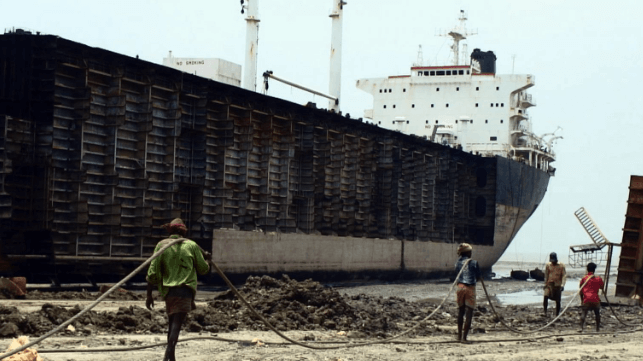Asian Shipbreaking Business Ends 2022 at Low Levels

The shipbreaking industry in Asia continued to be under pressure in 2022 both from increased scrutiny on recycling and safety as well as emerging financial issues. With shipowners hanging on to tonnage and looking for market rebounds, the pool of available ships for recycling has been declining. However, due to a range of issues, it is unclear what role India, Bangladesh, and Pakistan will play in a market rebound.
GMS, which describes itself as the “world’s largest buyer of ships and offshore vessels for recycling,” wrote in its year-end market summary “Sub-continent markets remain suspended at their weakest point for some time now. Pricing remains firm, but sentiments and conditions on the ground across all locations remain somewhat precarious.”
Asia’s largest ship-breaking operation historically has been at Alang, India but according to officials for the industry, the yards are experiencing their lowest levels in at least 15 years. Between April and December 2022, only 90 ships were beached in the district versus an average of 160 ships per year over the past six years. Between 2016 and 2021, the number ranged between 139 and 195 ships in the nine-month period of each year.
India’s Ship Recycling Industries Association is forecasting that the light displacement tonnage (LDT) beached at the yards may well be at its lowest level in over a decade. Their data shows that the last time the yards were at current levels was in 2005-2006 when they processed 480,000 LDT beaching 101 ships. Activity at the yards peaked in 2012-2013 at nearly 400 ships and 3.84 million LDT with the yards normally maintaining an output of over 2 million LDT annually.
The industry in India has been in a steady decline despite efforts to improve the yards and safety standards in line with the Hong Kong Convention that was ratified in 2009 to reduce the environmental impact of ship recycling. GMS points out that while the overall numbers have been dwindling, India had a recent advantage as none of the Pakistani yards and only a few in Bangladesh are HKC approved. None of the Asian yards however are EU approved.
Indian industry officials, however, point to other fundamental changes including a decision by the Bureau of Indian Standards that in 2012 changed guidelines removing certain recycled products from the approved list. They point out that this has forced the yards to divert more steel from re-rolling mills to the furnaces melting the scrap. They are getting less money for the scrap from the furnace operators, while at the same time, the Gujarat Maritime Board that oversees Alang raised the costs for plots on the beach.
The shipbreakers in Pakistan and Bangladesh were also increasingly price competitive with Alang in part because steel from ships accounts for a much higher percentage of the steel manufactured in those countries. However, according to GMS, the ongoing financial crisis in both Bangladesh and Pakistan is now hampering the yards’ ability to acquire new ships. They report that the Bangladeshi government restricted the sanctioning of new letters of credit, while at the end of the year, the Pakistani government also restricted the financing instruments.
Pakistan they point out remained the top price market at the close of 2022. The government’s action they however called “catastrophic to the industry, especially as vessels now start to arrive on the local waterfront.”

that matters most
Get the latest maritime news delivered to your inbox daily.
“No new market sales of any significance have reportedly taken place into Bangladesh over the last new months of 2022,” notes GMS. They conclude the outlook for the industry in Bangladesh “remains somewhat bleak,” until new cash can be injected into the sector.
All of this comes at a time when industry analysts expect there will be an increasing number of retired ships, especially containerships and from the dry bulk business, offered for recycling. Slowing global trade, the influx of newbuilds, and increasing environmental regulations are all expected to contribute to the number of ships being retired in 2023 and beyond.
